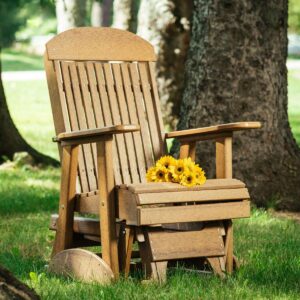In 2025, the world of outdoor furniture is evolving faster than ever. Driven by innovations in technology, sustainability, and design, consumers are now seeking more than just good-looking patio pieces. They want intelligent solutions that last longer, use eco-friendly materials, and blend style with functionality.
Whether you’re planning to revamp your backyard, upgrade your deck, or create a relaxing oasis in the garden, staying ahead of these emerging trends will ensure you choose pieces that serve both your lifestyle and the planet. In this article, we’ll explore the smart and sustainable outdoor furniture trends that are dominating 2025—and why they matter.

1. Eco-Friendly Materials Take Center Stage
The growing global emphasis on environmental responsibility has pushed manufacturers to rethink their material choices. In 2025, sustainable outdoor furniture is no longer niche—it’s mainstream.
Expect to see a rise in furniture made from:
- Recycled plastics that mimic wood but are more weather-resistant
- Bamboo and acacia wood, which are fast-growing and renewable
- Reclaimed teak, known for its natural durability and rich character
- Recycled aluminum, which is lightweight, rustproof, and energy-efficient to produce
These materials not only reduce your environmental footprint but also hold up beautifully to changing weather conditions, making them ideal for long-term use.
2. Modular and Multi-Functional Designs
As people aim to make the most of their outdoor spaces—regardless of size—modular furniture has become a game-changer. In 2025, flexibility is key.
Modular outdoor furniture allows homeowners to rearrange layouts depending on the occasion. A sectional sofa can split into chairs, a bench may double as a storage chest, and a coffee table could convert into a dining surface.
These intelligent designs save space, adapt to your needs, and add an element of customization that wasn’t as widely available in years past.
3. Smart Technology Integration
Just as homes are getting smarter, so is outdoor living. In 2025, outdoor furniture is embracing built-in technology to enhance convenience, comfort, and entertainment.
Some of the most exciting tech-driven trends include:
- Furniture with built-in wireless charging stations
- LED lighting embedded in tables or lounge chairs
- Bluetooth-enabled speakers integrated into side tables
- Smart heating and cooling cushions for year-round usability
This fusion of comfort and connectivity makes your outdoor space more livable, especially if you enjoy entertaining or relaxing outside throughout the year.
4. Weather-Resistant and Low-Maintenance Finishes
Another top trend in 2025 is the move toward low-maintenance materials that don’t compromise on style. Modern consumers want outdoor furniture that can withstand the elements without constant upkeep.
Powder-coated metal frames, UV-resistant wicker, performance fabrics, and moisture-resistant woods are at the forefront. These materials are designed to stay beautiful through harsh sun, rain, wind, or snow with minimal cleaning.
For those looking to furnish their space with high-quality pieces that stand the test of time, explore this selection of durable, weather-resistant outdoor furniture that balances style and strength.
5. Earthy Tones and Natural Textures
Design aesthetics are also shifting. In 2025, earthy tones like terracotta, olive green, sandy beige, and charcoal gray dominate outdoor furniture color palettes. These muted, natural hues blend effortlessly with surrounding landscapes and evoke a calming atmosphere.
Textured fabrics such as linen, rope, and bouclé are being paired with raw materials like stone tabletops and rattan details. This combination of tones and textures enhances the sense of connection to nature and makes outdoor areas feel just as curated as indoor spaces.
6. Circular Design and Longevity
A significant focus this year is circular design—a concept that encourages durability, recyclability, and repairability. More brands are committing to creating outdoor furniture pieces that can be disassembled, repaired, and recycled at the end of their life cycle.
This not only keeps waste out of landfills but also ensures customers are buying long-term investments rather than disposable decor. Expect manufacturers to offer extended warranties, refurbishing services, and even trade-in options.
Sustainability is no longer a buzzword—it’s becoming a core expectation from educated consumers.
7. Indoor-Outdoor Blending
In 2025, the line between indoor and outdoor furniture continues to blur. With advances in fabric technology and design aesthetics, outdoor pieces now mirror indoor styles. This trend, known as “bringing the indoors out,” creates a seamless transition from home interior to exterior.
Sofas with plush cushions, accent chairs with intricate detailing, and coffee tables with polished finishes now have a place in the open air. This trend elevates your backyard or patio from functional to luxurious.
Many of the latest collections of indoor-inspired outdoor furniture reflect this movement, offering timeless comfort with durable design.
8. Compact Furniture for Urban Living
Not everyone has sprawling outdoor spaces, and the industry is catching on. In 2025, there’s a noticeable rise in space-saving outdoor furniture built for balconies, terraces, and smaller patios.
Foldable chairs, stackable stools, nesting tables, and slimline sofas are helping city dwellers enjoy the outdoors without cluttering their limited square footage. The designs prioritize minimalism, smart engineering, and visual lightness.
9. Outdoor Workspaces
With remote work still prevalent in 2025, homeowners are finding creative ways to work outside. Furniture manufacturers are responding with ergonomic pieces designed for open-air productivity.
Weatherproof desks, swivel chairs with UV protection, and outdoor privacy screens are enabling professionals to create backyard offices. Blending comfort, function, and tech compatibility is essential to make outdoor workspaces just as productive as indoor ones.
10. Artisan and Handcrafted Pieces
Amid the rise of technology and sustainability, there’s also a renewed appreciation for craftsmanship. Handwoven wicker, carved wooden pieces, and artisan-made accessories are making a strong comeback.
These handcrafted touches add personality and uniqueness to your outdoor furniture, reflecting both style and substance. Many homeowners are choosing one-of-a-kind pieces that tell a story and support local artisans or ethical brands.
The future of outdoor furniture in 2025 is exciting, functional, and eco-conscious. With sustainable materials, smart features, stylish aesthetics, and adaptable designs leading the way, outdoor spaces are being transformed into sophisticated living environments.
By choosing wisely—investing in weather-resistant materials, supporting circular design, and integrating tech—you’re not just buying furniture. You’re curating a long-lasting outdoor lifestyle tailored to your needs and values.
And if you’re ready to start your journey toward a smarter, more stylish outdoor living space, explore the latest in sustainable and smart outdoor furniture to bring your backyard vision to life.




